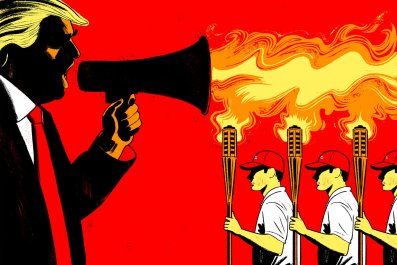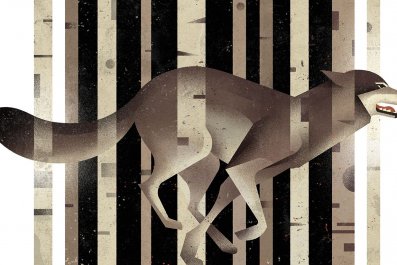Documentaries often boast "unbelievable" tales, but they rarely deliver. Tim Wardle's Three Identical Strangers actually lives up to its billing. It's "the single best story I've ever come across," says the director.
If you lived in New York City in the 1980s, the first half-hour of his film may be familiar. Three 19-year-old men became local celebrities after they discovered they were triplets separated at birth: Bobby Shafran met his mirror image, Eddy Galland, after he was mistaken for him at Sullivan County Community College in 1980. (Galland had dropped out the previous semester.) Once introduced, they assumed they were twins—until David Kellman saw their photo, his face times two, in a local paper reporting on Shafran and Galland's reunion.
The media and public were entranced by the story. Wardle's film shows their cameo opposite Madonna in 1985's Desperately Seeking Susan, and clip after clip of the three brothers on talk shows in matching clothes. Shafran and Kellman are interviewed throughout the film, but something is off: Where's Galland?
The answer comes in the film's second half: Their brother killed himself in June 1995.
Two months after Galland's death, a New Yorker reporter, Lawrence Wright, exposed a secret study, conducted in the 1960s and '70s by psychologist Peter Neubauer. The triplets had been among a larger group of multiple births in New York in which the siblings had been separated from one another, without informing the birth parents or the adoptive families, all of whom had used the a Jewish adoption agency in New York, Louise Wise Services. When the outraged parents learned of the separations and demanded an answer, officials told them that the separation was kept quiet because of the challenge of finding families willing to adopt three children.
The real reason was Neubauer's study; the goal, according to former researchers on the project, was to answer an age-old question: Is human disposition predestined by genetics or shaped by environment?
Kellman and Shafran are now 56. When Wardle first approached them about the film, they were hesitant. "The lights went out when Eddy died," says Shafran, a Brooklyn-based attorney. "When we first reunited, we got a lot of press and partying. But what started as a happy story had ended. We were wary of media people. We had moved on."
"This film was deeper than anything we've ever done with any media outlets," adds Kellman, who lives in New Jersey and works as an insurance consultant. "We weren't telling our story. We were opening up our lives."
Wardle, who previously directed the 2016 documentary One Killer Punch, spent nearly four years earning the brothers' trust. "Their relationship was not in a great place—it was more fractured than it used to be," says Wardle. "Even during filming, we never knew if they were going to suddenly pull out."
Shafran says it was challenging creating bonds with two strangers, even identical ones. "We didn't grow up as a family," he explains. "At first, we had nothing but joy and love. Then, the bickering began. We never learned how to argue and then make up."
Their initial fame had led to a joint business—a restaurant on New York's Lower East Side called, yes, Triplets. When Shafran quit, Galland took it the hardest. "Eddy was so obsessed with being a part of this family that he used to move, follow [Kellman and his wife] wherever they moved. He did that three times," says Wardle, a detail he ultimately left out of the doc. It was Kellman's wife at the time, Janet, who went across the street and found Galland after his death.

The film unfolds like a mystery. It seemed one element of the study was economic: Shafran went to an upper-class couple, Galland to a middle-class family and Kellman to working-class parents. All three spent time in psychiatric hospitals as teenagers, suggesting that they shared a predisposition for mental illness. Kellman—who reveals in the film that he used to beat his head against his crib as an infant—attributes it to subconscious separation anxiety.
And they weren't alone. Wardle includes other long-lost twins—placed by the same, now-closed adoption agency—who have discovered each other. All remember being observed by researchers as they grew up (their parents were told it was part of a study of adopted children). Many also suffered from depression and anxiety. At least three—including Galland, who was diagnosed with manic depression—committed suicide. Some theorized that the children were specifically selected from parents with a history of mental illness, but according to Kellman, the triplets' birth mother had no known diagnosis.
Wardle finds two people who worked with Neubauer and manages to uncover a few previously unknown clues (no spoilers), but many of the essential questions—Who else was an unwilling subject? What were the results?—have never been revealed, in the film or to the brothers. "There are a number of people living in New York, some still practicing psychiatry, who were much more involved in the study," says Wardle, "but they wouldn't talk to us."
"This is like Nazi shit," says Shafran in the film, but Wardle thinks that's going too far. The low-level researchers whom he interviewed "aren't evil. It's easy to judge the past by today's standards, but you have to make some allowances."
Once the New Yorker piece came out, journalists tried to get Neubauer to speak about the study; he refused because, he said, the results would someday be published. But they never were, and after he died in 2008, at 94, the Jewish Board of Family and Children's Services—where Neubauer served as director of what was previously the Child Development Center for years—placed the research in the Yale University archives under a seal until 2066, only to be released to individuals with written authority from the Jewish Board.
For years, victims, including Kellman, requested access and were denied. No one knows or is revealing what Neubauer's motives were in concealing his data for so long. In one of the film's most shocking revelations, a research assistant claims that at least four people from the study—out of an unverified estimate of 15 subjects or more—still don't know that they are an identical twin or triplet.
Three Identical Strangers has provoked some movement. Over 10,000 pages were released after it was completed, but all, according to Kellman, were heavily redacted. And after the film debuted at the 2018 Sundance Film Festival, winning a special jury award, Shafran and Kellman received a letter of apology from then-president of the Jewish Board, Alice Tisch.
Kellman is seeking a lot more than "a few words. They can't give us back our childhoods," he says, "but we want the study in its entirety, in a clear fashion, shared with the people that were involved. Then they should compensate everybody that they hurt." (A lawsuit has not been mentioned, but he says "all options are being explored.")
Since Galland died before the New Yorker piece, he never knew he was part of a study. His surviving brothers have lived with that knowledge for over 20 years. "If the movie affects you at all, just square then cube that," adds Shafran. "This is my life, which Tim captured with sensitivity and insight."
The film accomplished something else too, says Kellman. "It absolutely brought Bobby and I closer together."
Three Identical Strangers opens in limited release June 29 and nationwide on July 13.













